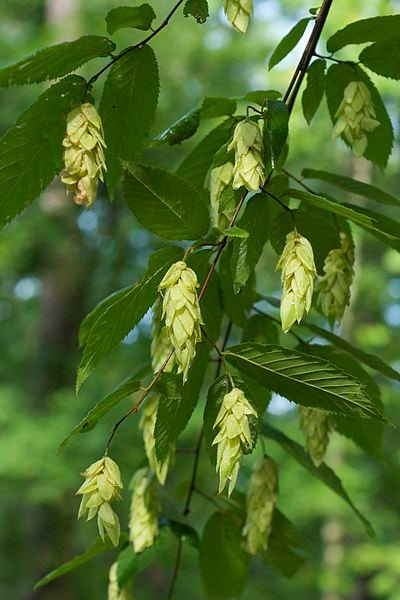Hop-hornbeam
Scientific Name: Ostrya virginiana
— pronounced OSS-tree-uh vir-jin-ee-AN-uh
— Ostrya is Latin, from Greek ostrus, the Common Hop-hornbeam; perhaps derived from Greek ostrakon, shell (of an animal), for the extremely hard wood. (The English "hornbeam" has a parallel derivation: horn, for wood as hard as horn; and Old English beam, tree)
– virginiana is late Latin, meaning “of Virginia”
Birch Family (Betulaceae), comprised of deciduous nut-bearing trees and shrubs, including the birches, alders, hazels, hornbeams, and hazel-hornbeams
Other Common Names: Ironwood, Leverwood
The Hop-hornbeam’s bark in maturity is gray and has a distinctive shredded look. Early in the tree’s life the bark is smooth and red-brown.
The leaves alternate on the stem. They are oval to broadly lance-shaped, narrowing to a point, with a double sawtooth edge. They’re green above; below, they’re pale, and fuzzy along the mid-vein.
— pronounced OSS-tree-uh vir-jin-ee-AN-uh
— Ostrya is Latin, from Greek ostrus, the Common Hop-hornbeam; perhaps derived from Greek ostrakon, shell (of an animal), for the extremely hard wood. (The English "hornbeam" has a parallel derivation: horn, for wood as hard as horn; and Old English beam, tree)
– virginiana is late Latin, meaning “of Virginia”
Birch Family (Betulaceae), comprised of deciduous nut-bearing trees and shrubs, including the birches, alders, hazels, hornbeams, and hazel-hornbeams
Other Common Names: Ironwood, Leverwood
The Hop-hornbeam’s bark in maturity is gray and has a distinctive shredded look. Early in the tree’s life the bark is smooth and red-brown.
The leaves alternate on the stem. They are oval to broadly lance-shaped, narrowing to a point, with a double sawtooth edge. They’re green above; below, they’re pale, and fuzzy along the mid-vein.
Photos: bark by David Rosher; leaves by
The Hop-hornbeam’s male flowers develop in late summer and are present throughout winter. The females appear in early spring, light green catkins less than 1/2 inch long.
The fruit consists of several leaf-like sacs hanging from a single stem, each containing a 1/4-inch nutlet. Green at first, the sacs turn brown as the fruit matures. "Hop" comes from the fruit’s resemblance to a hop vine’s fruit.
The Hop-hornbeam’s male flowers develop in late summer and are present throughout winter. The females appear in early spring, light green catkins less than 1/2 inch long.
The fruit consists of several leaf-like sacs hanging from a single stem, each containing a 1/4-inch nutlet. Green at first, the sacs turn brown as the fruit matures. "Hop" comes from the fruit’s resemblance to a hop vine’s fruit.
Photos: flowers (female) by Eric Hunt CC; fruits by Peter Dziuk
More photos and ID help: VA Tech Dendrology
Hop-hornbeam is a small to medium understory tree, 20 to 40 feet high, highly shade-tolerant. It’s usually found in upland areas and is very common here in the Brushy Hills Preserve.
Interesting facts:
More photos and ID help: VA Tech Dendrology
Hop-hornbeam is a small to medium understory tree, 20 to 40 feet high, highly shade-tolerant. It’s usually found in upland areas and is very common here in the Brushy Hills Preserve.
Interesting facts:
- This species grows slowly and typically lives 100 years, with a maximum lifespan of 150. It’s usually 25 years old before bearing significant fruit.
- It’s a host plant for the larvae of many species of butterflies and moths. Its nutlets are a minor winter food for mammals and birds.
- Hop-hornbeam typically retains a number of dried brown leaves through the winter months.



